Scottish Local Government Finance Statistics (SLGFS) 2018-19
Annual publication providing a comprehensive overview of financial activity of Scottish local authorities in 2018-19 based on authorities' audited accounts.
This document is part of a collection
3. Capital Expenditure and Financing
Capital expenditure is expenditure that creates an asset, extends the life of an asset, or increases the value of an asset. It creates the buildings and infrastructure necessary to provide services, such as schools, care homes, flood defence, roads, vehicles, plant and machinery. Capital expenditure also includes:
- grants a local authority provides to a third party to fund capital expenditure of the third party;
- direct expenditure on a third parties’ assets; and
- loans to third parties to support capital investment of the third party where this is financed either from capital grant or borrowing, i.e. from capital resources.
Capital expenditure can be financed by one or more of the following:
- capital grants and contributions;
- borrowing or credit arrangements;
- contributions from capital or revenue reserve funds;
- capital receipts from the sale of assets.
Due to the nature of capital expenditure, it can fluctuate substantially between years.
Local authorities also hold capital reserves, more information on these is provided in Chapter 4.1.
3.1 Capital Expenditure
In 2018-19, total capital expenditure was £2,977 million, which is consistent with expenditure of £2,984 million in 2017-18. Capital expenditure of local authorities can be grouped into four categories:
- acquisition of land, leases, existing buildings or works;
- new construction, conversions and enhancement to existing buildings;
- vehicles, machinery and equipment;
- intangible assets (see Chapter 4.2).
Capital grants, direct expenditure and capital loans to third parties makes up a further, fifth category of capital expenditure.
Chart 3.1 shows the split of capital expenditure into these five categories in 2018-19. The majority of capital expenditure, £2,317 million or 78 per cent, related to new construction, conversions & enhancements to existing buildings.
Chart 3.1: Capital Expenditure in 2018-19 by Expenditure Type, £ millions
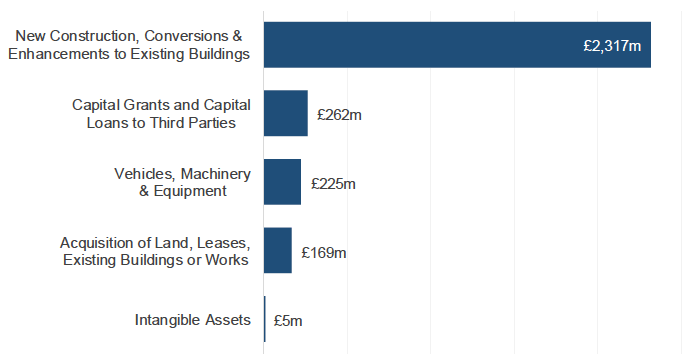
Source: CR Final
Table 3.1 shows the breakdown of capital expenditure between 2014-15 and 2018-19. New construction, conversions and enhancements to existing building has consistently accounted for the majority of capital expenditure over this period.
Table 3.1: Capital Expenditure from 2014-15 to 2018-19 by Expenditure Type, £ millions 1
| 2014-15 | 2015-16 | 2016-17 | 2017-18 | 2018-19 | |
|---|---|---|---|---|---|
| Acquisition of Land, Leases, Existing Buildings or Works | 64 | 58 | 233 | 363 | 169 |
| New Construction, Conversions & Enhancements to Existing Buildings | 1,949 | 2,097 | 2,358 | 2,255 | 2,317 |
| Vehicles, Plant, Machinery & Equipment | 174 | 183 | 193 | 185 | 225 |
| Intangible Assets | 14 | 6 | 10 | 5 | 5 |
| Capital Grants and Capital Loans to Third Parties | 199 | 192 | 168 | 177 | 262 |
| Total Capital Expenditure | 2,400 | 2,535 | 2,962 | 2,984 | 2,977 |
Source: CR Final
Notes
1 The 2018-19 figure split by General Fund and HRA are available in tab Chart 3.1 in the associated Excel file.
3.3.1 Capital Expenditure by Service
Chart 3.2 shows capital expenditure in 2018-19 by service. HRA had the largest share of expenditure at £742 million, followed by Education with £665 million. Together these services account for almost half, 47 per cent, of capital expenditure. Trading Services had the smallest share at only £18 million, or one per cent of total expenditure.
Chart 3.2: Capital Expenditure in 2018-19 by Service, £ millions
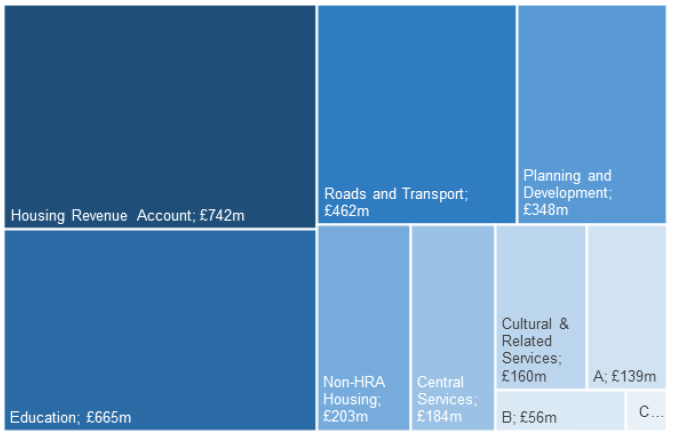
Source: CR Final
Notes
A = Environmental Services
B = Social Work
C = Trading Services, £18m
Chart 3.3 shows capital expenditure for 2014-15 to 2018-19 for each service that accounts for more than five per cent of total expenditure to be met from capital resources. Expenditure on both HRA and Planning and Development services has shown continued increases from 2015-16 and 2016-17 respectively.
Capital expenditure on Education has decreased by 26 per cent from £899 million in 2017-18 to £665 million in 2018-19. This follows increases in expenditure in each of the prior four years and so the decrease likely reflects the end of a programme of capital investment in Education.
Chart 3.3: Capital Expenditure from 2014-15 to 2018-19 by Service, £ millions 1
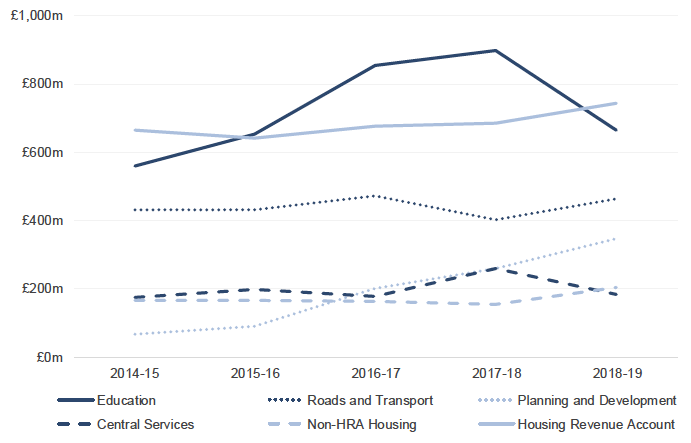
Source: CR Final
Notes:
1 This chart excludes expenditure relating to Culture and Related Services, Social Work, Environmental Services and Trading Services as they each make up five per cent or less of the total capital expenditure in 2018-19. Figures for these services are available in tab ‘Chart 3.3’ in the associated Excel file.
3.1.2 Capital Expenditure by Local Authority
In any given year, capital expenditure per person varies substantially between local authority areas. This will in part reflect the different priorities of local authorities, however it also reflects differences in the timing of capital projects. Expenditure on capital projects can be highly variable as some projects can be high-value and infrequent, and expenditure per head in local authority areas will move, possibly substantially, from year to year as projects begin or wind down.
Chart 3.4 shows capital expenditure on General Fund services per person by council. VJBs, RTPs and Tay Road Bridge have been excluded from this analysis. In 2018-19, the average capital expenditure per person for Scotland was £411, a decrease from £424 per person in 2017-18. Spend per person ranged from £186 per person in South Lanarkshire to £1,009 per person in Aberdeen City.
Chart 3.4: General Fund Capital Expenditure in 2018-19 by Council, £ per person
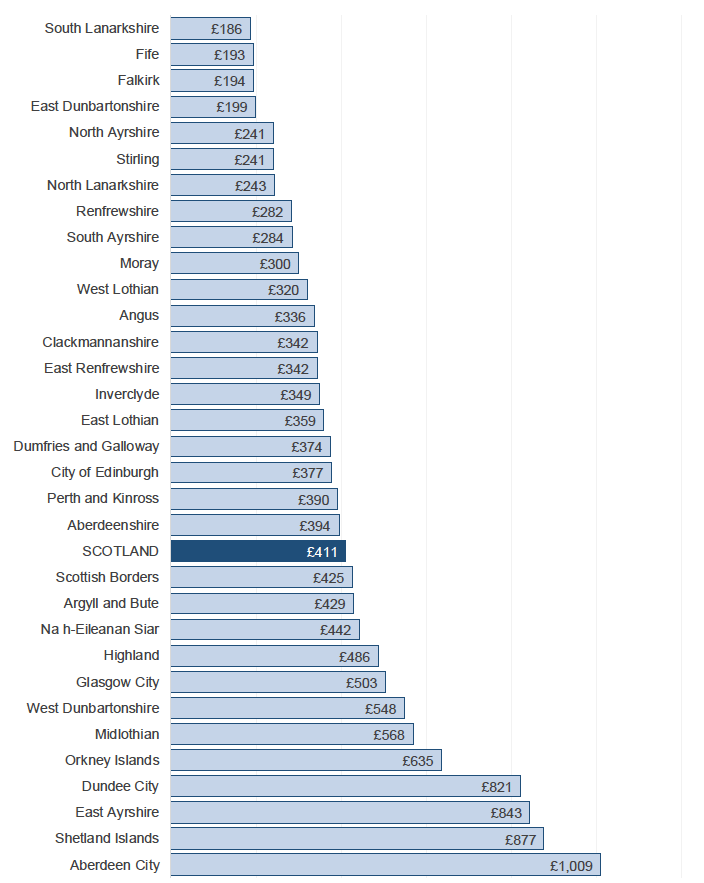
Source: CR Final, Mid-Year Population Estimates
3.2 Capital Financing
Chart 3.5 shows how local authorities financed their capital expenditure in 2018-19. Borrowing from the Loans Fund was used to finance £1,128 million, almost two-fifths, of expenditure to be met from capital resources. Scottish Government General Capital Grant and Specific Capital Grant together were used to finance £916 million, just under one-third of expenditure. A total of £301 million, ten per cent, of expenditure was funded from revenue reserves.
Chart 3.5: Capital Financing in 2018-19 by Source, £ millions
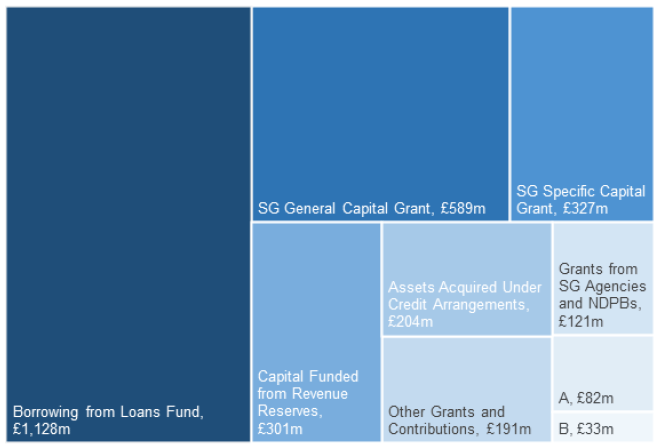
Source: CR Final, Mid-Year Population Estimates
Notes:
A = Capital Receipts Used from Asset Sales / Disposals
B = Capital Reserves (Capital Fund)
Chart 3.6 shows capital financing by type from 2014-15 to 2018-19. Borrowing has consistently been the largest source of funding across this period. The fluctuations in borrowing reflect the nature of capital and can be influenced by the type of expenditure being undertaken in each year.
Scottish Government General Capital Grant has consistently been the second largest source of funding in this five year period. It should be noted that reprofiling of capital funding was agreed between the Scottish Government and CoSLA and this has impacted the following figures: the 2014-15 figure includes an additional £120 million, reprofiled from 2012-13; the 2015-16 figure includes an additional £94.2 million, reprofiled from 2013-14; the 2016-17 figure excludes £150 million that has been reprofiled and included in the 2019-20 capital settlement.
Financing from assets acquired under credit arrangements decreased in 2018-19, following a notable two year increase between 2015-16 and 2017-18.
Chart 3.6: Capital Financing from 2014-15 to 2018-19 by Source, £ millions 1, 2
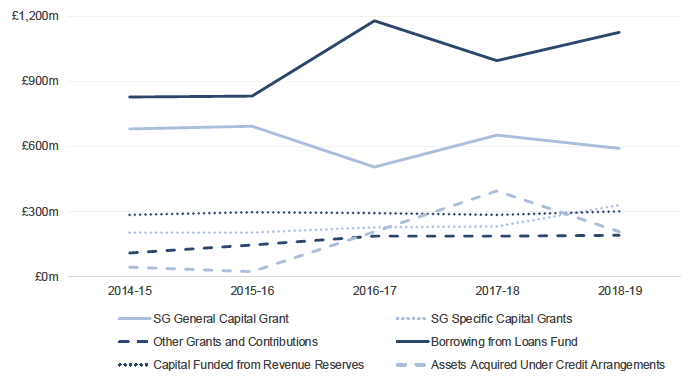
Source: CR Final
Notes
1 This chart excludes financing from grants from SG Agencies and NDPBs; Capital Receipts used from Asset Sales / Disposals; and Capital Reserves as they each make up five per cent or less of total capital financing in 2018-19. Figures for these services are available in tab ‘Chart 3.6’ in the associated Excel file.
2 Borrowing from the Loans Fund includes borrowing used to fund grants to third party capital projects. This will be also counted under revenue income.
3.2.1 Capital Grants
Capital grants are grants provided to local authorities to fund capital investment. The Scottish Government provides two types of grant funding to local authorities – a General Capital Grant and a number of specific or ring-fenced grants. Scottish Government agencies, such as Transport Scotland, and Non-Departmental Bodies, such as sportscotland, may also award grants for projects.
Other grants and contributions include grants from other local authorities, European Structural Funds, contributions from private developers or persons, and the use of additional income from changes to council tax discounts on second homes and long-term empty properties.
As shown in Chart 3.6, Scottish Government specific capital grants have remained largely stable between 2014-15 and 2017-18, with a more notable increase between 2017-18 and 2018-19. This is because a specific capital grant of £150 million for Early Years Expansion was first paid to local authorities in 2018-19. Other grants and contributions have remained largely stable since 2016-17 and the trend for the Scottish Government General Capital Grant is discussed in Chapter 3.2.
3.2.2 Capital Receipts
Capital receipts is the term used to recognise income from the sale or disposal of a fixed asset, such as land or council housing. Under statute, capital receipts may only be used to fund capital expenditure or for the repayment of debt.
Local authorities can also hold capital receipts for future use which means the value of capital receipts received may not equal the amount of capital receipts used. Table 3.2 provides a summary of capital receipts for 2018-19.
Table 3.2: Capital Receipts Summary for 2018-19, £ thousands 1
| General Fund | HRA | Total | |
|---|---|---|---|
| Capital Receipts brought forward at 1 April 2018 | 99,798 | 8,400 | 108,198 |
| Capital Receipts from the sale / disposal of Fixed Assets | 92,384 | 18,908 | 111,292 |
| Total Capital Receipts Available for Use | 192,182 | 27,308 | 219,490 |
| Capital Receipts used to Finance Capital Expenditure | 63,352 | 18,527 | 81,879 |
| Capital Receipts used to Repay Debt | 17,369 | 142 | 17,511 |
| Capital Receipts transferred to the Capital Grants and Receipts Unapplied Account | 2,026 | 0 | 2,026 |
| Capital Receipts transferred to Capital Fund | 10,701 | 0 | 10,701 |
| Capital Receipts Held at 31 March 2019 | 98,734 | 8,639 | 107,373 |
Source: CR Final
Notes
1 A breakdown of capital receipts held at 31 March from 2014-15 to 2018-19 by service is available in Table 3.2a in the associated Excel file.
Local authorities brought forward a balance of £108 million of capital receipts at 1 April 2018. A further £111 million of capital receipts were raised during the year, giving a total of £219 million of capital receipts available for use during 2018-19.
The main use of capital receipts in 2018-19 was to finance capital expenditure, accounting for £82 million. A total of £18 million of capital receipts was used to repay debt and a further £13 million of capital receipts was transferred to other capital reserves. This resulted in a capital receipts balance of £107 million at 31 March 2019.
3.2.3 Borrowing and Credit Arrangements
Local authorities can borrow to fund capital expenditure, either through the borrowing of money or by way of a credit arrangement, such as a lease. The cost of repaying debt, including the interest costs, is expenditure to the revenue accounts. The costs of servicing debt in 2018-19 are provided in Table 2.5 which shows the cost of repayments and interest payable.
The Local Government (Scotland) Act 1973 provides councils with a general power to borrow money. Other local authorities’ powers are set out in legislation specific to that authority. The Local Authority (Capital Finance and Accounting) (Scotland) Regulations 2016 sets out the purposes for which a local authority may borrow.
Table 3.3 provides a summary of borrowing and credit arrangements in 2018-19. Local authorities determined they would fund £1,128 million of capital expenditure from borrowing in 2018-19, an increase of 13 per cent from £998 million in 2017-18. In 2018-19, local authorities also entered into credit arrangements, recognising debt of £204 million, a decrease of 48 per cent from £394 million in 2017-18.
The majority of borrowing relates to the General Fund, with only £314 million Loans Fund advances for capital expenditure relating to the HRA.
Table 3.3: Borrowing and Credit Arrangement Summary for 2018-19, £ million 1
| General Fund | HRA | Total | |
|---|---|---|---|
| Advances for Capital Expenditure 2 | 790 | 314 | 1,103 |
| Advances for Consented Borrowing | 25 | 0 | 25 |
| Total Loans Fund Borrowing | 814 | 314 | 1,128 |
| Credit Arrangements | 204 | 0 | 204 |
| Total Borrowing and Credit Arrangements | 1,018 | 314 | 1,332 |
Source: CR Final
Notes
1 Figures for 2014-15 to 2018-19 are available in Table 3.3a in the associated Excel file.
2 Advances for Capital Expenditure includes borrowing from the loans fund used to fund grants to third party capital projects. Local authorities may have also included this within their revenue figures.
Trends for borrowing from the Loans Fund and credit arrangements between 2014-15 and 2018-19 are shown in Chart 3.6 and discussed in Chapter 3.2.
Contact
Email: lgfstats@gov.scot
There is a problem
Thanks for your feedback